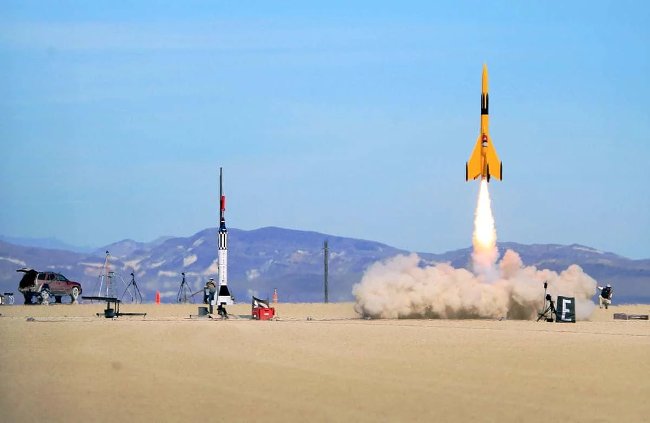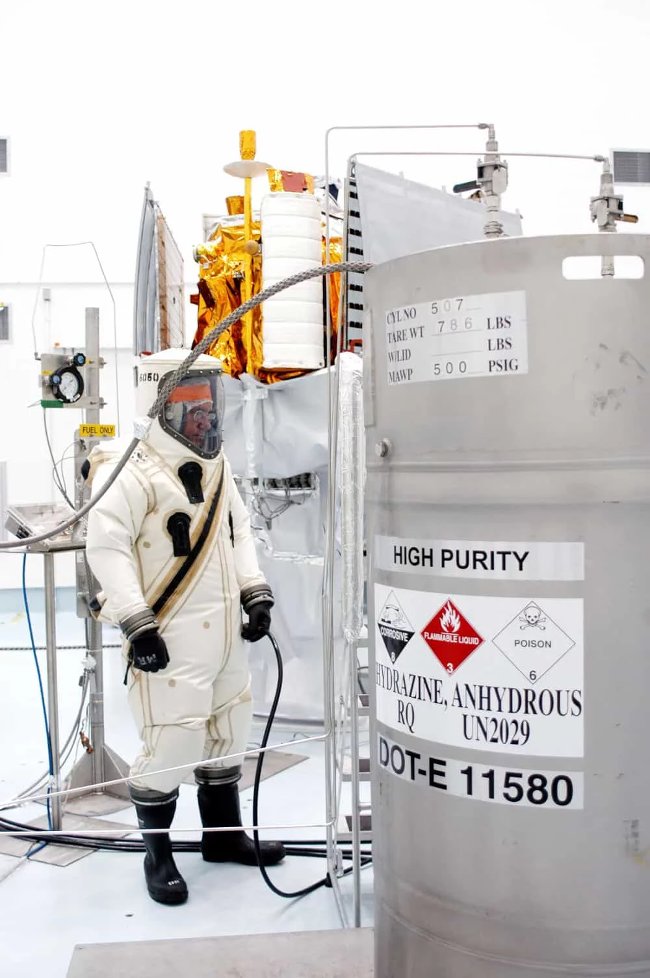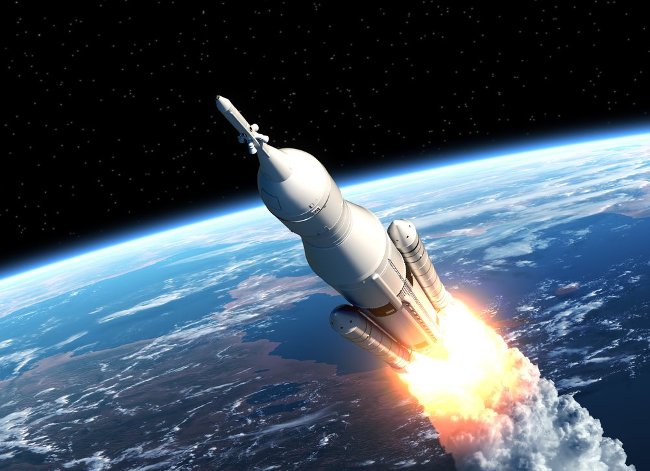Fire needs air to burn, so how does the rocket work in space?
- How fast can a rocket fly to win gravity and escape the Earth?
- Is Elon Musk's plan to send people to Mars feasible?
- SpaceX reversed the plan to launch missiles on Mars by 2020
Commercial airplanes and fighter planes burn fuel by using the oxygen available in the atmosphere, but what about missiles flying into space? In fact, there is no air in aerospace, so how can rockets ignite essential engines and fuels needed in space?
Short answer : Only two components are needed for the combustion reaction, which is fuel and oxidation . Most cosmic rockets carry their fuel and oxidants into space, so they don't need to rely on the oxygen available in that space. Furthermore, it is not necessary to fire to provide rocket propulsion; You can gain thrust by simply pushing " mass " out of the rocket.
 Rocket in space.Image source: 3dsculptor / Fotolia)
Rocket in space.Image source: 3dsculptor / Fotolia)
How can rockets work in space?
Almost in space there is no air, so how can rockets work there? Because they have no air to repel, so how to accelerate or change the direction?
Certainly one of us has also learned about Newton's Law of Motion in high school. All forms of movement in this world are thought to be dominated by three major laws of Newton's motion, missiles are no exception.
Observe the most basic form of motion - walking . To be able to walk, we have to set our feet firmly on the ground and then push back to the ground, then move forward.
 When walking on the ground, the repulsive force helps us step forward.That's the basic thing we can do when walking.Image source: Pixabay
When walking on the ground, the repulsive force helps us step forward.That's the basic thing we can do when walking.Image source: Pixabay
Of course, this seems silly to think that we, with weak legs, can " push " the ground, but that's exactly what happens. Because the Earth's mass is significantly larger than the body weight, the ground does not really push back. The type of action reaction is governed by Newton's Law III , which states that " for every action, there is always a reaction of the same magnitude and vice versa ".
You can follow the law of motion III in countless cases. Suppose there are two small boats in the middle of the lake. If a person jumps from one boat to another, the first boat will be pushed backwards as soon as the person jumps.

It is this law that helps rockets move and transform in space. Rocket engine is a jet engine. To move forward, a rocket launches high-pressure gas ( produced by the combustion reaction ) from its tail. Therefore, the action ( air spray ) activates the reaction ( ie the missile moves forward ).
However, as mentioned above, gas emitted from combustion and combustion reactions, a traditional combustion reaction, requires oxygen to burn. After all, we all know that there is no air in the air.
So . what is the alternative here?
How can rockets work in space without oxygen?
Fire cannot burn without two important elements: fuel ( flammable ) and oxidizing agent ( start the combustion process and maintain it ). So you need fire to propel the rocket, but there is not enough air ( oxidizing agent ) in space. So what can be done?
In fact, this is really simple: if you go to the drawing competition, but that place doesn't give you the color paints, what will you do? Do you bring your own paint? Very simple!
That's exactly what most space spacecraft do. Many rockets carry a liquid oxygen tank, which acts as the oxidant needed to maintain the combustion reaction. The most commonly used fuels in rockets are liquid hydrogen or kerosene.

Fuel and oxidants combine inside the rocket to start the burning reaction.
In fact, thousands of oxidation-fuel combinations have been used in aerospace missiles over the years, but liquid hydrogen and liquid oxygen are still one of the most effective mixes.
Solid rocket fuel
Note that you do not necessarily need to use oxygen as an oxidizer. Almost all solid-fuel rocket engines use aluminum powder as fuel and ammonium perchlorate, composite propellant fuel ( solid rocket propellant used in manned and unmanned rocket vehicles. ) as an oxidizer.
 A rocket was launched using solid fuel.Photo source: Steve Jurvetson / Wikimedia Commons
A rocket was launched using solid fuel.Photo source: Steve Jurvetson / Wikimedia Commons
Hyperbolic push explosives
As mentioned above, you don't need oxygen to create fire inside a rocket, because there are certain chemicals - when exposed to each other - naturally burn.Propellants that use these chemicals are called hyperbolic propellants .
The most common hyperbolic fuels include hydrazine, monomethylhydrazine and unsymmetrical dimethylhydrazine, often used together with nitrogen tetrachloride ( oxidizing agent ) to activate self-igniting, meaning you do not need oxygen to produce fire.
 The supply of fuel ( containing hydrazine as fuel ) is loaded into the space ship MESSENGER.Photo source: NASA / Wikimedia Commons
The supply of fuel ( containing hydrazine as fuel ) is loaded into the space ship MESSENGER.Photo source: NASA / Wikimedia Commons
Monopropellant (Single component fuel)

These propellants include chemicals that release energy and release mass after chemical decomposition. This fuel often contains substances such as hydrazine or concentrated hydrogen peroxide exposed to iridium catalysts.Monopropellant - one-component fuel commonly used in reactive controllers, provides height adjustment.
All of the above mentioned is to say that, while oxygen is definitely an essential oxidant on Earth to create fire, on the contrary, you don't necessarily need to use oxygen to propel the missiles in space. By having a few other alternatives!
Having fun!
You should read it
- SpaceX reversed the plan to launch missiles on Mars by 2020
- Should metal gears be used in space missions?
- Explore the moon and extremely detailed planets with new features on Google Maps
- Recycle space waste, impossible thought possible!
- Travel space with splendid images of the universe
- Unique new rockets can enter space in just 5 minutes
- 11 interesting facts about ISS International Space Station not everyone knows
- SpaceX's Crew Dragon spacecraft successfully assembled with the ISS station, completely automated
May be interested
- Make fire letters, fire letters on the website
 you access forums or websites online and see the signature or the name of the admin is burning, you think silently how they do. actually there is a way to make fire letters, here and there.
you access forums or websites online and see the signature or the name of the admin is burning, you think silently how they do. actually there is a way to make fire letters, here and there. - How to Burn MP4 to DVD
 this wikihow teaches how to burn an mp4 video file onto a blank dvd disc. in order to make a dvd playable in most dvd players, you'll need to use free software such as dvd flick (windows) or burn (mac). if you just want to store the mp4 or...
this wikihow teaches how to burn an mp4 video file onto a blank dvd disc. in order to make a dvd playable in most dvd players, you'll need to use free software such as dvd flick (windows) or burn (mac). if you just want to store the mp4 or... - For the first time in history, SpaceX successfully launched Falcon 9 reusable missiles
 elon musk's spacex succeeded in launching a space ship with a used falcon 9 rocket, and landed it on the platform of course i still love you at sea, marking an important milestone. in the history of the universe.
elon musk's spacex succeeded in launching a space ship with a used falcon 9 rocket, and landed it on the platform of course i still love you at sea, marking an important milestone. in the history of the universe. - How fast can a fire spread?
 the video below is set up by the new zealand fire service center to show you how scary the fire can be. it only came from a small fire, but in less than 1 minute, the entire room was burned down.
the video below is set up by the new zealand fire service center to show you how scary the fire can be. it only came from a small fire, but in less than 1 minute, the entire room was burned down. - Video: Close-up of the terrifying power of the 'super rocket' that fired 100 arrows at once in the 15th century
 hwacha is a very famous korean archery machine. this article will show you the terrible power of hwacha.
hwacha is a very famous korean archery machine. this article will show you the terrible power of hwacha. - How to Burn MP4 to DVD
 today's tipsmake will guide you how to burn mp4 video files to blank dvd discs. to play dvds on most dvd players, you'll need to use free software such as dvd flick (windows) or burn (mac). if you want to store mp4 videos or just play them on your computer, you can burn the files to dvd using the built-in burning software.
today's tipsmake will guide you how to burn mp4 video files to blank dvd discs. to play dvds on most dvd players, you'll need to use free software such as dvd flick (windows) or burn (mac). if you want to store mp4 videos or just play them on your computer, you can burn the files to dvd using the built-in burning software. - SpaceX reveals photos showing the terrifying power of Starship's Raptor engine
 spacex has just posted a series of amazing photos showing the power of the super heavy rocket's 33 raptor engines, as they simultaneously fired up and provided energy to lift the starship rocket off the launch pad during a test flight on november 19.
spacex has just posted a series of amazing photos showing the power of the super heavy rocket's 33 raptor engines, as they simultaneously fired up and provided energy to lift the starship rocket off the launch pad during a test flight on november 19. - How to get items in the Free Fire x Spacespeakers event
 free fire always knows how to make gamers excited when it constantly launches unique and beautiful new skin packs. during the latest free fire space speaker royale event, players will be able to receive 4 eye-catching limited edition spacespeakers packs.
free fire always knows how to make gamers excited when it constantly launches unique and beautiful new skin packs. during the latest free fire space speaker royale event, players will be able to receive 4 eye-catching limited edition spacespeakers packs. - How to Burn a DVD on a Mac
 apple computers are installed with a utility that helps you to burn cds and dvds. dvds hold larger amounts of data than cds. you can create a customized dvd within a few minutes. follow these steps to burn a dvd on a mac computer....
apple computers are installed with a utility that helps you to burn cds and dvds. dvds hold larger amounts of data than cds. you can create a customized dvd within a few minutes. follow these steps to burn a dvd on a mac computer.... - How to get Free Fire Diamonds for free in January 2021
 don't count on apps that promise to give you free fire diamonds for free because they don't work as advertised. instead, apply the legal, but time-consuming, safe and secure ways to get free fire diamonds that tipsmake shares shortly.
don't count on apps that promise to give you free fire diamonds for free because they don't work as advertised. instead, apply the legal, but time-consuming, safe and secure ways to get free fire diamonds that tipsmake shares shortly.










 The lost twin brothers of the Sun may be the culprits for the destruction of dinosaurs
The lost twin brothers of the Sun may be the culprits for the destruction of dinosaurs 2 more moons found around Jupiter
2 more moons found around Jupiter Video: Cassini spacecraft successfully performs the journey around Saturn
Video: Cassini spacecraft successfully performs the journey around Saturn black hole, white hole, deep hole
black hole, white hole, deep hole How big is the solar system?
How big is the solar system? Detecting the tremors of the 'twin brothers' of the solar system, the key to deciphering early life
Detecting the tremors of the 'twin brothers' of the solar system, the key to deciphering early life